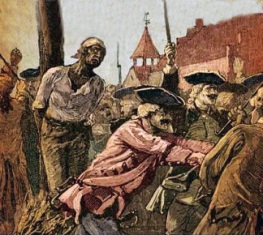Conspiracy of 1741
March 18, 1741: The New York governor’s house in Fort George catches fire. Soon after, the church connected to the house was also ablaze. The locals tried to extinguish the fire but it soon grew out of control and threatened to spread to even more buildings, especially worrisome was the building housing all the city documents. The windows were broken and the documents were thrown outside to save them. They were moved to City Hall. A fire broke out the next week and was quickly put out and the following week a warehouse caught fire. Three days later a cow stable caught fire and on the following day, someone passing through a wealthy neighborhood saw coals near some hay and extinguished the smoldering hay and thus keeping the neighborhood from going up in flames.
As the numbers of fires increased, so did the idea that it was not accidental, as was often the case when fires were used for cooking and heating and buildings were made of easily combustible wood. On April 6, four fires were started and a black man was seen running away while a while man yelled after him, “A negro, a negro.” It was then the fires were seen as a conspiracy and the entire plot was seen as a slave insurrection. This was not a completely unfounded idea as Manhattan in New York City was home to the second largest slave population in the colonies, after Charleston, South Carolina. This gave rise to the Conspiracy of 1741 also called the Negro Plot of 1741 or the Slave Insurrection of 1741.
There was economic competition between poor whites and slaves. A severe winter and war between England and Spain added to the mix along with anti-Catholic and anti-Spanish sentiments. There had been recent slave revolts in South Carolina and Saint John in the Caribbean. The slave seen running away, Cuffee, was arrested and within a few days, 100 slaves had been jailed. Mary Burton, a 16-year-old Irish indentured servant had been arrested for theft. She testified against others, claiming the poor whites and slaves were trying to burn the city, kill all the white men, take the white women for their own, and then elect a new king and governor. Eventually, about 200 people were arrested and as panic spread and a few testified against the others, over 100 people were hanged, exiled, or burned at the stake. Most of the “guilty” were hanged or burned, but it is unclear how many died.
Today, historians do not agree as to whether there was a conspiracy at all and if there was, what scale it reached. During the cases, the prosecution was inconsistent, changing accusations and their case of a slave revolt morphed into a Popish plot of Catholics. The two supposed leaders of the revolt were Caesar, a slave, and John Hughson, a white cobbler and tavern keeper. They were executed and their bodies were left to rot in public. At least 72 men were deported from New York and sent to various other regions among the American colonies.
It goes without saying that a civilization which leaves so large a number of its participants unsatisfied and drives them into revolt neither has nor deserves the prospect of a lasting existence. – Sigmund Freud
The right to revolt has sources deep in our history. – William O. Douglas
Most commonly revolt is born of material circumstances; but insurrection is always a moral phenomenon. Revolt is Masaniello, who led the Neapolitan insurgents in 1647; but insurrection is Spartacus. Insurrection is a thing of the spirit, revolt is a thing of the stomach. – Victor Hugo
Revolt and terror pay a price. Order and law have a cost. – Carl Sandburg
Also on this day: New London, Texas – In 1937, a school explosion took place in Texas.
Jacques Trumped – In 1314, Jacques de Molay was burned at the stake.
Tri-State Tornado – In 1925, a destructive tornado traveled across three state.
We’ve Got the Power – In 1937, a pedal craft flew the distance.
Martyrs to the Cause – In 1834, the Tolpuddle Martyrs were sentenced.

leave a comment